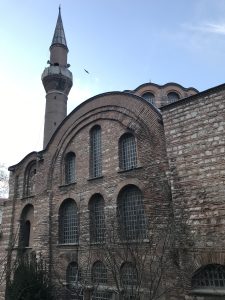“The cashiers”
Until recently the roughly triangular area behind Beyazıt Meydanı that is called Vezneciler lacked any very obvious identity. The coming of a new Metro station, however, means that more people now find their way here to visit the Şehzade and Kalenderhane Camis.
If you walk north from Ordu Caddesi beside the Beyazıt Hamamı and then the Hasan Paşa Medrese you will emerge in Vezneciler near the sebil attached to the Kuyucu Murad Pasa Medrese, dating back to 1606. Alas, most of the rest of the medrese is obscured by the clothing stalls lining the pavement although it seems likely that they will eventually be cleared away and the entire complex cleaned up.
The medrese stands in the grounds of İstanbul University’s Faculty of Literature building which was designed by Sedat Hakkı Eldem and Emin Onant in 1951. Excavations in the grounds have uncovered the remains of several small Byzantine churches. The finds can be seen in the Beyazıt Hamamı Museum.
 If instead you emerge from the Metro station at Vezneciler and turn down 16 Mart Şehitler Caddesi you will come, on the left, to the impressive Kalenderhane Cami that started life as the brick-built 12th-century Byzantine Church of Theotokas Kyriotissa. It sits in a dip alongside a small garden just in front of the Aqueduct of Valens. Despite the rubbish piled up in the garden you can just about make out traces of an earlier church on the site as well as slight traces of a Roman bath.
If instead you emerge from the Metro station at Vezneciler and turn down 16 Mart Şehitler Caddesi you will come, on the left, to the impressive Kalenderhane Cami that started life as the brick-built 12th-century Byzantine Church of Theotokas Kyriotissa. It sits in a dip alongside a small garden just in front of the Aqueduct of Valens. Despite the rubbish piled up in the garden you can just about make out traces of an earlier church on the site as well as slight traces of a Roman bath.
It’s a great shame that you can no longer see the greatest treasures of the church which were a 7th-century mosaic showing the Presentation of the Christ Child in the Temple and a cycle of frescoes depicting the life of St Francis of Assisi believed to have been applied to the wall in 1250 during the half-century of Latin rule that followed the arrival of the Fourth Crusade in Constantinople in 1204. All were removed to the İstanbul Archaeological Museum but are not generally on display. Immediately after the Conquest in 1453 the church was handed to the Kalendar dervishes for use as a lodge at which time a single minaret was added to the exterior.
If you walk beneath the arches of the aqueduct you will come to the Süleymaniye neighbourhood. Alternatively, return to Vezneciler Caddesi (the busy main road) and turn right onto Şehzadebaşi Caddesi. Opposite a pair of large hotels you will see a string of small shops and restaurants built into rather ramshackle old buildings that look likely to disappear any day soon. The shops – once part of the Damat İbrahim Paşa complex, much of which still survives – stand on the site of the Direklerarası arcaded bazaar. The name Direklerarası (“between the columns” in Turkish) commemorated a double arcade of 82 shops fronted by porticoes that had been added to the complex in 1728-29 to provide funds for its maintenance, the design probably a conscious attempt to recall the lost colonnaded streets of Byzantium. Both columns and arcades fell victim to urban “improvements” between 1864 and 1957.
Direklerarası slowly evolved into the main centre for evening entertainment during Ramadan although these days that’s all ancient history. One huge shoe-shop turns out to be housed inside one of the old cinemas that eventually took root here before the entertainment centre shifted its focus north to Beyoğlu.
What’s in a name. 16 Mart Şehitleri Caddesi runs up from Vezneciler Metro station to Suleymaniye, its name commemorating a largely forgotten episode at the start of the occupation of İstanbul in 1920 when British troops killed six men in a military post in Vezneciler.
Transport info
You can easily walk to Vezneciler from Sultanahmet or Beyazıt. Alternatively you can get here by Metro from Taksim or Yenikapı.
Nearby areas


